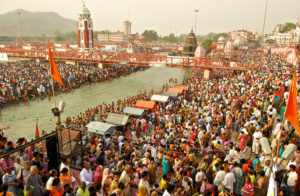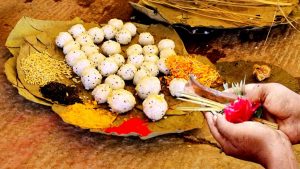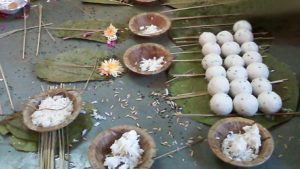Durva Ashtami – Significance of Durva Grass
Durva Ashtami (29-Aug-2017)
Durva Ashtami is a unique Hindu observance dedicated to worship of Durva Grass, an essential item used in Hindu rituals. It is observed on the ‘ashtami’ (8th day) during the ‘Shukla Paksha’ (the bright fortnight of moon) in the lunar month of ‘Bhadrapada’ as per the Hindu calendar. However in the Gregorian calendar, the date falls between the months of August-September. This Hindu festival is celebrated with immense gaiety and enthusiasm in West Bengal and other eastern regions of India. In Bengal, it is popularly referred as ‘Durvashtami Brata’.
Rituals during Durva Ashtami
The rituals during Durva Ashtami are mainly observed by women. They get up before sunrise, take an early bath and wear new clothes prior to staring the puja rituals. On this day, women offer special rituals and pujas to Durva Grass. The auspicious Durva Grass is worshiped with flowers, fruits, rice, incense sticks, curd and other essential puja items. Women also keep a fast on this day. The observer of the Durva Ashtami Vrat also worships Lord Shiva and Lord Ganesha. Along with fruits and flowers, Durva Grass is also offered to please the Lords. Women perform the puja with full dedication for the long life and prosperity of their children. It also helps to bring peace and harmony in their married life. On Durva Ashtami, Hindu devotees offer food and clothes to a respected Brahmin. Doing so will bestow them with endless wealth and good fortune.
Legends about Durva Grass
There is a mention of Durva in the Rig Veda and Atharvana Veda. According to Bhavishya Purana, Durva emerged from Lord Vishnu’s hair on his hand and thighs while he supported mount Mandara during the Samudra Manthan as a Turtle. After the Samudra Manthan when the Asuras and Devas were carrying the ‘Amrit’, it is believed that few drops of Amrit fell on Durva Grass and since then it became auspicious and immortal.
According to Vamana Purana, Durva emerged from Vasuki’s tail- the snake which was used to churn the Ocean during Samudra Manthana. In Ramayana, Sita is said to have placed a blade of Durva between Herself and Ravana during her confinement in Ashoka Vana. She had warned Ravana not to cross the grass.
Another reference is that there once a demon Analasur terrified the world and the Devas who then approached Lord Shiva seeking protection. Lord Shiva asked them to visit Lord Ganesha as he would be able to put an end to the demon. Devas approached Ganesha and sought protection from Analasur. Lord Ganesha fought a battle with Analasur and swallowed him. It caused a lot of agony to Lord Ganesha. Lord Indra gave him the moon to be worn on his forehead so that he could have a cooling effect. Hence, Lord Ganesha is also known as Balachandra. Lord Vishnu gave him a Lotus flower. Lord Varuna showered rain on him, but the suffering of Lord Ganesha did not reduce. It was then that 88,000 saints performed Archana to Lord Ganesha with 21 Durva grass each. Lord Ganesha was cured of his stomach ailment. Thus Lord Ganesha is worshipped with 21 Durva Grass on Ganesha Chaturthi day.
Benefits of Celebrating Durva Ashtami
According to the Hindu beliefs, observing Durva Ashtami with full devotion brings prosperity and peace in one’s life and gets all his/her desires fulfilled. Furthermore it is believed that a person who consumes only raw foods on Durva Ashtami is freed from all his/her sins, even those equivalent to killing of a Brahmin. The significance of Durva Grass was also explained to King Yudhisthira by Lord Krishna himself. Lord Krishna stated that a man who religiously performs the Durva Ashtami puja will be blessed to keep his legacy moving forward, from generations to generations.
Reach us to be a part of our whatsapp spiritual reminder group








